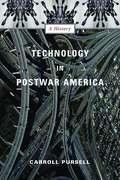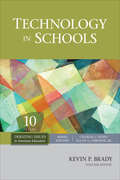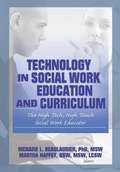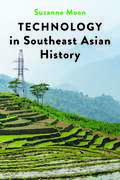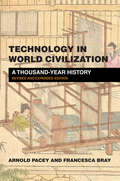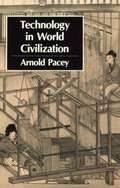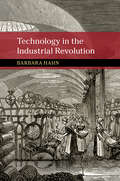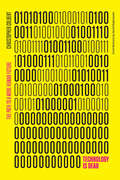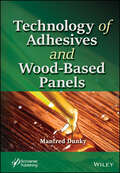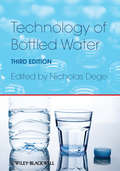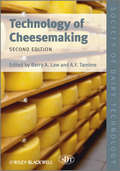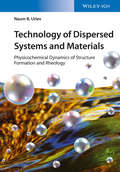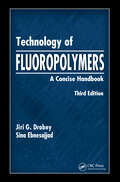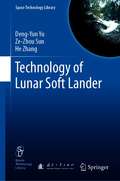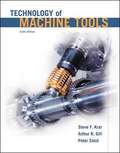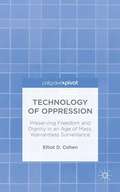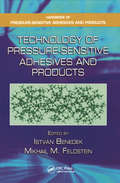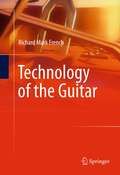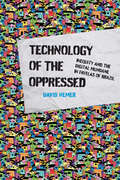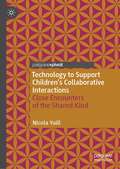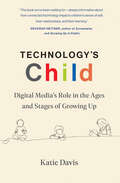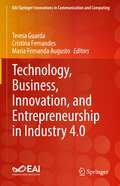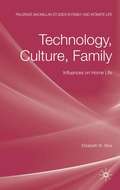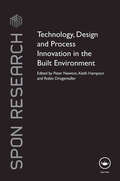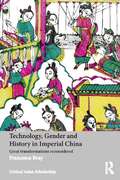- Table View
- List View
Technology in Postwar America: A History
by Carroll PursellCarroll Pursell tells the story of the evolution of American technology since World War II. His fascinating and surprising history links pop culture icons with landmarks in technological innovation and shows how postwar politics left their mark on everything from television, automobiles, and genetically engineered crops to contraceptives, Tupperware, and the Veg-O-Matic.Just as America's domestic and international policies became inextricably linked during the Cold War, so did the nation's public and private technologies. The spread of the suburbs fed into demands for an interstate highway system, which itself became implicated in urban renewal projects. Fear of slipping into a postwar economic depression was offset by the creation of "a consumers' republic" in which buying and using consumer goods became the ultimate act of citizenship and a symbol of an "American Way of Life." Pursell begins with the events of World War II and the increasing belief that technological progress and the science that supported it held the key to a stronger, richer, and happier America. He looks at the effect of returning American servicemen and servicewomen and the Marshall Plan, which sought to integrate Western Europe into America's economic, business, and technological structure. He considers the accumulating "problems" associated with American technological supremacy, which, by the end of the 1960s, led to a crisis of confidence.Pursell concludes with an analysis of how consumer technologies create a cultural understanding that makes political technologies acceptable and even seem inevitable, while those same political technologies provide both form and content for the technologies found at home and at work. By understanding this history, Pursell hopes to advance a better understanding of the postwar American self.
Technology in Schools
by Kevin P. BradyEducation of America's school children always has been and always will be a hot-button issue. From what should be taught to how to pay for education to how to keep kids safe in schools, impassioned debates emerge and mushroom, both within the scholarly community and among the general public. This volume in the point/counterpoint Debating Issues in American Education reference series tackles the topic of technology in schools. Fifteen to twenty chapters explore such varied issues as the digital divide, electronic textbooks, impacts on curricula, privacy on school computers, web censorship, and more. Each chapter opens with an introductory essay by the volume editor, followed by point/counterpoint articles written and signed by invited experts, and concludes with Further Readings and Resources, thus providing readers with views on multiple sides of technology issues within America's schools and pointing them toward more in-depth resources for further exploration.
Technology in Social Work Education and Curriculum: The High Tech, High Touch Social Work Educator
by Florence W Vigilante Richard L Beaulaurier Martha F HaffeySave time and trouble as you incorporate technology into your social work curriculumThe dramatic increase in the use of computers and other forms of technology in social work education and practice has educators, trainers, and administrators investing valuable time, money, and effort into trying to make the transition from traditional teaching to a Web-assisted learning environment. Technology in Social Work Education and Curriculum takes the mystery out of the online experience with practical information on using technology to enhance and enrich learning-but not at the expense of the "human" approach to social work. This unique book presents a variety of creative and interesting methods for incorporating technology that&’s affordable and user-friendly, and for developing online skills that won&’t become obsolete as computer hardware and software evolves.Technology in Social Work Education and Curriculum transforms technology into an everyday resource for agency field instructors, human service educators, trainers, and social work administrators. The book addresses concerns that educators with limited technical skills may have in using technology to teach cultural competency, group work, research, direct practice, social policy and advocacy, and field practicum, presenting hands-on approaches that are innovative but accessible. And by focusing on approaches rather than simply reviewing available hardware and software, the book provides you with background knowledge that makes it easier for you to successfully incorporate online learning into the classroom. Technology in Social Work Education and Curriculum examines using instructional technology to emotionally engage students in the learning process using digital video and qualitative data analysis software to teach group practice the role technology plays in advocacy distance-education technologies in policy education incorporating Web-assisted learning into a traditional classroom setting the advantages of distance education over more conventional approaches a model for planning the use and integration of computer technology in schools of social work how the behaviors of computer consultants can affect the students who seek their help using innovation diffusion theory in technology planning and much more!Social workers have traditionally embraced the latest technologies and scientific developments since the earliest days of the profession. Technology in Social Work Education and Curriculum helps continue that tradition, offering invaluable guidance to educators and administrators, no matter how experienced-or inexperienced-they are in dealing with communications technologies.
Technology in World Civilization, revised and expanded edition: A Thousand-Year History
by Francesca Bray Arnold PaceyThe new edition of a milestone work on the global history of technology.This milestone history of technology, first published in 1990 and now revised and expanded in light of recent research, broke new ground by taking a global view, avoiding the conventional Eurocentric perspective and placing the development of technology squarely in the context of a "world civilization." Case studies include "technological dialogues" between China and West Asia in the eleventh century, medieval African states and the Islamic world, and the United States and Japan post-1950. It examines railway empires through the examples of Russia and Japan and explores current synergies of innovation in energy supply and smartphone technology through African cases.The book uses the term "technological dialogue" to challenges the top-down concept of "technology transfer," showing instead that technologies are typically modified to fit local needs and conditions, often triggering further innovation. The authors trace these encounters and exchanges over a thousand years, examining changes in such technologies as agriculture, firearms, printing, electricity, and railroads. A new chapter brings the narrative into the twenty-first century, discussing technological developments including petrochemicals, aerospace, and digitalization from often unexpected global viewpoints and asking what new kind of industrial revolution is needed to meet the challenges of the Anthropocene.
Technology in World Civilization: A Thousand-Year History
by Arnold PaceyMost general histories of technology are Eurocentrist, focusing on a main line of Western technology that stretches from the Greeks is through the computer. In this very different book, Arnold Pacey takes a global view, placing the development of technology squarely in a "world civilization." He portrays the process as a complex dialectic by which inventions borrowed from one culture are adopted to suit another.Arnold Pacey is a physicist turned historian whose publications have contributed to the British appropriate-technology movement. He has written widely on science, technology, and agriculture. His previous books include The Maze of Ingenuity and The Culture of Technology.
Technology in the Industrial Revolution (New Approaches to the History of Science and Medicine)
by Barbara HahnTechnological change is about more than inventions. This concise history of the Industrial Revolution places the eighteenth-century British Industrial Revolution in global context, locating its causes in government protection, global competition, and colonialism. Inventions from spinning jennies to steam engines came to define an age that culminated in the acceleration of the fashion cycle, the intensification in demand and supply of raw materials and the rise of a plantation system that would reconfigure world history in favour of British (and European) global domination. In this accessible analysis of the classic case of rapid and revolutionary technological change, Barbara Hahn takes readers from the north of England to slavery, cotton plantations, the Anglo-Indian trade and beyond - placing technological change at the centre of world history.
Technology is Dead: The Path to a More Human Future
by Chris ColbertHow did we end up here, masters of scientific insight, purveyors of ever more powerful technologies, astride the burning planet that created us, and now responsible for cleaning up the mess and determining the future direction of all of life? And what do we do about it?Technology is Dead is a book that attempts to answer both of those questions. It is a book of both challenge and hope, written for those who are able or willing to lead us out of our global predicament. It is a book for everybody: the politicians, CEOs, community leaders, everyday parents, and young people who understand that we must change our ways to ensure a sustainable future for all living things and the planet we rely on.
Technology of Adhesives and Wood-Based Panels (Adhesion and Adhesives: Fundamental and Applied Aspects)
by Manfred DunkyThe book provides essential insights into the critical role of adhesive bonding in maximizing the value of wood products, equipping both students and industry professionals with the knowledge necessary to enhance production processes and improve product performance. Adhesive bonding of wood is a key factor in the efficient utilization of wood for the production of value-added wood products, such as wood-based panels. The production of wood-based panels requires high-performance bonds between wood adherends and the properties of these wooden products are largely determined by the type and performance of the adhesive used. Technology of Adhesives and Wood-Based Panels comprehensively covers wood-based panels, focusing on the technologies behind their raw materials and their production. Journey through the production process: starting with the raw materials, then application of adhesives onto the wood’s surfaces, pressing the mat to the board, and curing or solidifying the adhesive. Finally, this journey will culminate in an investigation of the properties of the bondline in wood-based panels. This volume explores important concepts, including the influence of wood materials and surface on wood bonding, the performance of wood-based panels, the production technology of panels, and the behavior of adhesives when applied to wood surfaces, making it a valuable resource to industry professionals and students alike. Readers will find that this book: Introduces wood adhesives and their chemistry and applications; Comprehensively covers the technology of wood-based panels; Explores connections for properties and performance between adhesives and bonded products; Provides recent developments in wood adhesives and wood-based panels. Audience Engineers, chemists, scientists, researchers, students, production managers and technologists in the wood, wood-based panel, and adhesive industries.
Technology of Bottled Water
by Nicholas DegeThe fully revised third edition of this unique and comprehensive overview of the science and technology of the bottled waters industry contains brand new chapters which address these new developments. As well as an updated introductory chapter reviewing the market, the degree to which the global legislative and regulatory picture has changed is examined, and new and increasingly-used quality standards are assessed. The book provides a definitive source of reference for all those involved in bottled water production: beverage technologists, packaging technologists, analytical chemists, microbiologists and health and safety personnel.
Technology of Cheesemaking (Society of Dairy Technology #18)
by A. Y. Tamime Barry A. LawNow in a fully-revised new edition, this book covers the science and technology underlying cheesemaking, as practised today in the manufacture of hard, semi-soft and soft cheeses. Emphasis is placed on the technology, and the science and technology are integrated throughout. Authors also cover research developments likely to have a commercial impact on cheesemaking in the foreseeable future within the areas of molecular genetics, advanced sensor / measurement science, chemometrics, enzymology and flavour chemistry. In order to reflect new issues and challenges that have emerged since publication of the first book, the new chapters are included on milk handling prior to cheesemaking; packaging; and major advances in the control of the end user properties of cheese using key manufacturing parameters and variables. The volume has been structured to flow through the discrete stages of cheese manufacture in the order in which they are executed in cheese plants - from milk process science, through curd process science, to cheese ripening science and quality assessment. Overall, the volume provides process technologists, product development specialists, ingredients suppliers, research and development scientists and quality assurance personnel with a complete reference to cheese technology, set against the background of its physical, chemical and biological scientific base.
Technology of Dispersed Systems and Materials: Physicochemical Dynamics of Structure Formation and Rheology
by Naum B. UrievThis practical guide is devoted to the field of physical chemistry and chemical technology of disperse systems and materials. It provides a novel approach describes and allows to understand the physical chemistry of structure formation and materials synthesis under dynamic conditions. Substantiated by experimental results, the general theory is developed in the first two chapters. The following chapters deal with the fundamental aspects of rheology, vibrorheology, and superfluidity of structured dispersed systems within the framework of physicochemical dynamics, and the last chapter exemplifies the technological applications of the developed methodology.
Technology of Fluoropolymers: A Concise Handbook
by Sina Ebnesajjad Jiri G. DrobnyThis third edition has been updated and expanded, providing industrial chemists, technologists, environmental scientists, and engineers with an accurate, compact, and practical source of information on fluoropolymers. Highlighting existing and new industrial, military, medical, and consumer goods applications, this edition adds more detailed information on equipment and processing conditions. It explores breakthroughs in understanding property-structure relationships, new polymerization techniques, and the chemistry underlying polymers, such as melt-processable fluoroplastics. It also expands on the important properties of fluoropolymers, including heat and radiation degradation, health effects, and recycling. Features: • Revised, updated, and expanded to continue to provide an accurate, compact, and practical source of information on fluoropolymers • Explores the property-structure relationships, polymerization techniques, and the chemistry underlying polymers • Fluoropolymers rank high on the specialty polymers group and, due to their unique properties, are naturally part of the solution to the industrial sustainability challenges of the twenty-first century • Describes the technology of fluoropolymers, including thermoplastic and elastomeric products • Expands upon the important characteristics of fluoropolymers and their recycling.
Technology of Lunar Soft Lander (Space Technology Library #38)
by He Zhang Deng-Yun Yu Ze-Zhou SunThis book provides systematic descriptions of design methods, typical techniques, and validation methods for lunar soft landers, covering their environmental design, system design, sub-system design, assembly, testing and ground test validation based on the Chang’e-3 mission. Offering readers a comprehensive, systematic and in-depth introduction to the technologies used in China’s lunar soft landers, it presents detailed information on the design process for Chang’e-3, including methods and techniques that will be invaluable in future extraterrestrial soft lander design. As such, the book offers a unique reference guide for all researchers and professionals working on deep-space missions around the globe.
Technology of Machine Tools (6th edition)
by Steve F. Krar Arthur R. Gill Peter SmidTechnology of Machine Tools provides state-of-the-art training for using machine tools in manufacturing technology, including up-to-date coverage of computer numerical control. It includes an overview of machine trades and career opportunities followed by theory and application. The text is structured to provide coverage of tools and measurement, machining tools and procedures, drilling and milling machines, computer-aided machining, and metallurgy. There is expanded coverage of computer-related technologies, including computer numerical control (CNC) and computer-aided design and manufacturing (CAD/CAM).
Technology of Oppression: Preserving Freedom and Dignity in an Age of Mass, Warrantless Surveillance
by Elliot D. CohenIn the wake of the National Security Agency expose of 2013, scholars and citizens alike have been turning a critical eye toward United States surveillance policies. Technology of Oppression contributes to this ongoing discussion with a systematic analysis of mass surveillance in America and allied countries, detailing how lax intelligence laws have allowed these technologies to undermine common civil liberties. Toward the practical end of reigning in existing surveillance technologies, Cohen offers a concise proposal listing the policy changes and software developments necessary to establish an internet-based, global forum for transparently affecting legal and technological change. "
Technology of Pressure-Sensitive Adhesives and Products
by Istvan Benedek Mikhail M. FeldsteinDiscussing the manufacture technology of pressure-sensitive adhesive and products, Volume 2 of the Handbook of Pressure-Sensitive Adhesives and Products includes the synthesis of pressure-sensitive raw mater
Technology of the Guitar
by Richard Mark FrenchFeaturing chapters on physics, structure, sound and design specifics, Technology of the Guitar also includes coverage of historical content, composition of strings and their effects on sound quality, and important designs. Additionally, author Mark French discusses case studies of historically significant and technologically innovative instruments. This is a complete reference useful for a broad range of readers including guitar manufacturer employees, working luthiers, and interested guitar enthusiasts who do not have a science or engineering background.
Technology of the Oppressed: Inequity and the Digital Mundane in Favelas of Brazil (The Information Society Series)
by David NemerHow Brazilian favela residents engage with and appropriate technologies, both to fight the oppression in their lives and to represent themselves in the world. Brazilian favelas are impoverished settlements usually located on hillsides or the outskirts of a city. In Technology of the Oppressed, David Nemer draws on extensive ethnographic fieldwork to provide a rich account of how favela residents engage with technology in community technology centers and in their everyday lives. Their stories reveal the structural violence of the information age. But they also show how those oppressed by technology don&’t just reject it, but consciously resist and appropriate it, and how their experiences with digital technologies enable them to navigate both digital and nondigital sources of oppression—and even, at times, to flourish. Nemer uses a decolonial and intersectional framework called Mundane Technology as an analytical tool to understand how digital technologies can simultaneously be sites of oppression and tools in the fight for freedom. Building on the work of the Brazilian educator and philosopher Paulo Freire, he shows how the favela residents appropriate everyday technologies—technological artifacts (cell phones, Facebook), operations (repair), and spaces (Telecenters and Lan Houses)—and use them to alleviate the oppression in their everyday lives. He also addresses the relationship of misinformation to radicalization and the rise of the new far right. Contrary to the simplistic techno-optimistic belief that technology will save the poor, even with access to technology these marginalized people face numerous sources of oppression, including technological biases, racism, classism, sexism, and censorship. Yet the spirit, love, community, resilience, and resistance of favela residents make possible their pursuit of freedom.
Technology to Support Children's Collaborative Interactions: Close Encounters of the Shared Kind
by Nicola YuillThis book explores how technology can foster interaction between children and their peers, teachers and other adults. It presents the Co-EnACT framework to explain how technology can support children to collaborate, so helping them to learn and engage enjoyably with the world, in both work and play. The focus is on children, rather than young people, but the principles of supporting interaction apply throughout all life stages. Chapters on classrooms and on autism explain principles behind using technology in ways that support, rather than obstruct, social interaction in diverse populations. Collaborative interaction involves both verbal and non-verbal behaviour and this book presents evidence from closely analysing children’s behaviour in natural settings. Examples from cutting-edge technology illustrate principles applicable to more widely-available technology. The book will be of interest to psychologists, educators, researchers in Human–Computer Interaction (HCI), particularly those designing with children in mind, and practitioners working with children who want to deepen their understanding of using technology for collaboration.
Technology's Child: Digital Media’s Role in the Ages and Stages of Growing Up
by Katie DavisHow children engage with technology at each stage of development, from toddler to twentysomething, and how they can best be supported.What happens to the little ones, the tweens, and the teenagers, when technology—ubiquitous in the world they inhabit—becomes a critical part of their lives? This timely book brings much-needed clarity to what we know about technology&’s role in child development. Better yet, it provides guidance on how to use what we know to help children of all ages make the most of their digital experiences. From toddlers who are exploring their immediate environment to twentysomethings who are exploring their place in society, technology inevitably and profoundly affects their development. Drawing on her expertise in developmental science and design research, Katie Davis describes what happens when child development and technology design interact, and how this interaction is complicated by children&’s individual characteristics and social and cultural contexts. Critically, she explains how a self-directed experience of technology—one initiated, sustained, and ended voluntarily—supports healthy child development, especially when it takes place within the context of community support. Children&’s experiences with technology—their &“screen time&” and digital social relationships—have become an inescapable aspect of growing up. This book, for the first time, identifies the qualitative distinctions between different ages and stages of this engagement, and offers invaluable guidance for parents and teachers navigating the digital landscape, and for technology designers charting the way.
Technology, Business, Innovation, and Entrepreneurship in Industry 4.0 (EAI/Springer Innovations in Communication and Computing)
by Teresa Guarda Maria Fernanda Augusto Cristina FernandesThis book presents the most recent innovations, trends, and challenges in several aspects of Industry 4.0, including the key technologies and business impacts. The book is relevant to a variety of stakeholders due to Industry 4.0’s broad impact in many fields. Topics include digital workplace solutions for employee engagement, entrepreneurship and innovation, and Blockchain for business security. The authors cover Industry 4.0 both from a theoretical and applicable standpoint.
Technology, Culture, Family
by Elizabeth B. SilvaThis book examines connections between personal, relational and material matters in everyday life in the context of broader and long standing social problems. It explores the connections between mundane practices in the reproduction of our bodies and our relations with those we live with, and the technological practices that inform daily life.
Technology, Design and Process Innovation in the Built Environment (Spon Research)
by Keith Hampson Peter Newton Robin DrogemullerBuildings and infrastructure represent principal assets of any national economy as well as prime sources of environmental degradation. Making them more sustainable represents a key challenge for the construction, planning and design industries and governments at all levels; and the rapid urbanisation of the 21st century has turned this into a global challenge. This book embodies the results of a major research programme by members of the Australia Co-operative Research Centre for Construction Innovation and its global partners, presented for an international audience of construction researchers, senior professionals and advanced students. It covers four themes, applied to regeneration as well as to new build, and within the overall theme of Innovation: Sustainable Materials and Manufactures, focusing on building material products, their manufacture and assembly – and the reduction of their ecological ‘fingerprints’, the extension of their service lives, and their re-use and recyclability. It also explores the prospects for applying the principles of the assembly line. Virtual Design, Construction and Management, viewed as increasing sustainable development through automation, enhanced collaboration (such as virtual design teams), real time BL performance assessment during design, simulation of the construction process, life-cycle management of project information (zero information loss) risk minimisation, and increased potential for innovation and value adding. Integrating Design, Construction and Facility Management over the Project Life Cycle, by converging ICT, design science engineering and sustainability science. Integration across spatial scales, enabling building–infrastructure synergies (such as water and energy efficiency). Convergences between IT and design and operational processes are also viewed as a key platform increased sustainability.
Technology, Gender and History in Imperial China: Great Transformations Reconsidered (Asia's Transformations/Critical Asian Scholarship)
by Francesca BrayWhat can the history of technology contribute to our understanding of late imperial China? Most stories about technology in pre-modern China follow a well-worn plot: in about 1400 after an early ferment of creativity that made it the most technologically sophisticated civilisation in the world, China entered an era of technical lethargy and decline. But how are we to reconcile this tale, which portrays China in the Ming and Qing dynasties as a dying giant that had outgrown its own strength, with the wealth of counterevidence affirming that the country remained rich, vigorous and powerful at least until the end of the eighteenth century? Does this seeming contradiction mean that the stagnation story is simply wrong, or perhaps that technology was irrelevant to how imperial society worked? Or does it imply that historians of technology should ask better questions about what technology was, what it did and what it meant in pre-modern societies like late imperial China? In this book, Francesca Bray explores subjects such as technology and ethics, technology and gendered subjectivities (both female and male), and technology and statecraft to illuminate how material settings and practices shaped topographies of everyday experience and ideologies of government, techniques of the self and technologies of the subject. Examining technologies ranging from ploughing and weaving to drawing pictures, building a house, prescribing medicine or composing a text, this book offers a rich insight into the interplay between the micro- and macro-politics of everyday life and the workings of governmentality in late imperial China, showing that gender principles were woven into the very fabric of empire, from cosmology and ideologies of rule to the material foundations of the state and the everyday practices of the domestic sphere. This authoritative text will be welcomed by students and scholars of Chinese history, as well as those working on global history and the histories of gender, technology and agriculture. Furthermore, it will be of great use to those interested in social and cultural anthropology and material culture.
